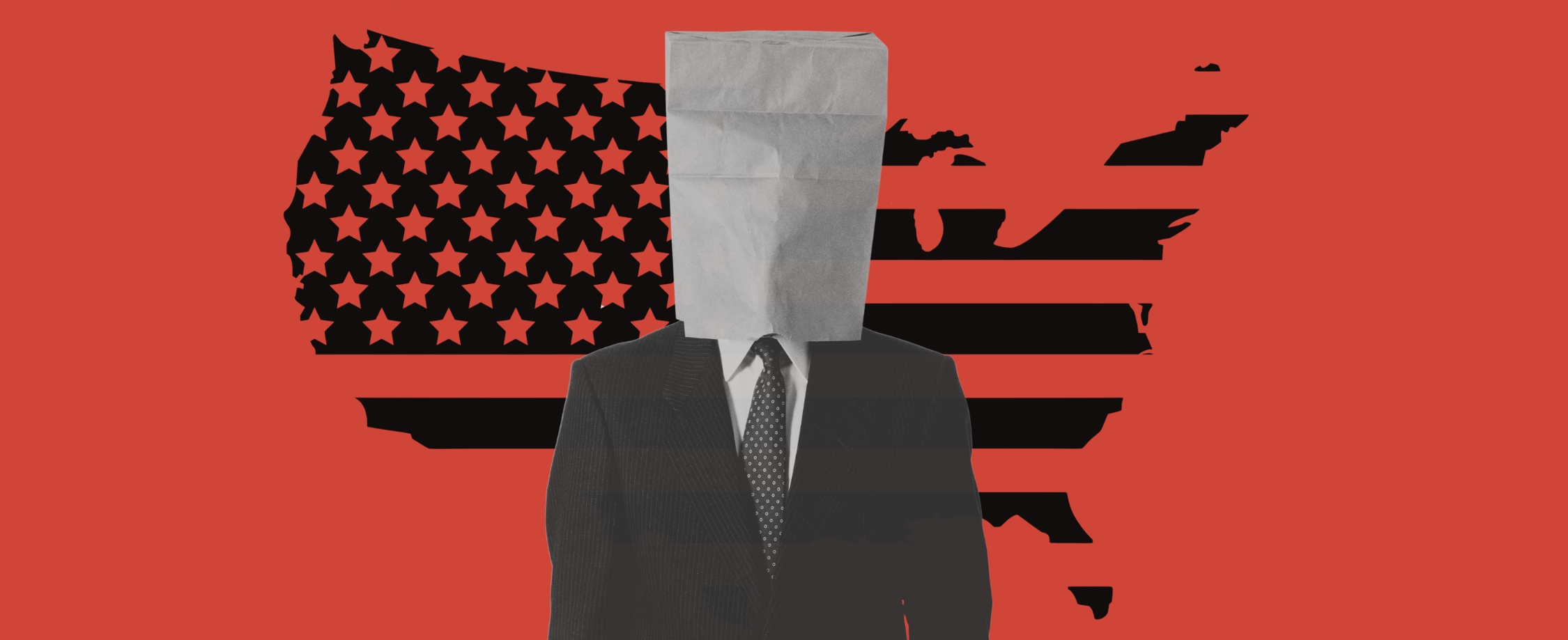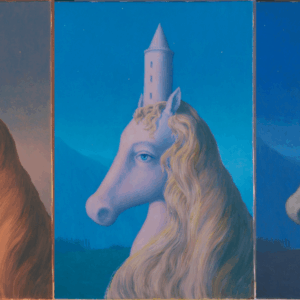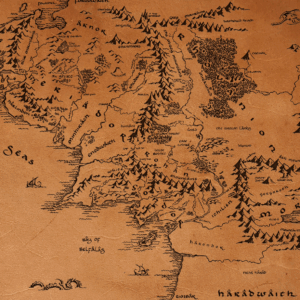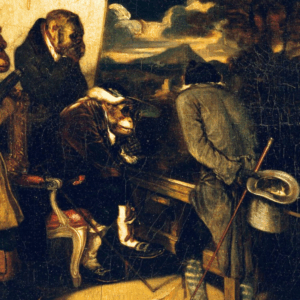
Thomas Pynchon Has Been Warning Us About American Fascism the Whole Time
For Devin Thomas O’Shea, This is Pynchon’s USA and We’re Just Living In It
Paul Thomas Anderson’s adaptations of Thomas Pynchon’s novels—first Inherent Vice in 2014, and now One Battle After Another in 2025—may be tipping the scales, with more first-time Pynchon readers finding his work through movies rather than university English departments.
Throughout the 1980s, long into the 1990s, Pynchon’s readers arrived at his work through the massive pipeline of American Literature 101: The Crying of Lot 49 makes for ideal syllabus fodder. The novella checked several boxes: students were introduced to “Postmodernism;” it covers the 1960s as a historical decade; it is slim (151 pages long), a reasonable length for college students to cover in a week before moving on to Toni Morrison and Maxine Hong Kingston.
In other words, the vast majority of those who’ve come in contact with Pynchon’s work are college graduates who enter through Oedipa Maas, a California housewife turned counterculture detective. But even for elite university students, Lot 49’s disorienting prose concerning the Tristero conspiracy, and the 1960s paranoia of San Narciso, takes time to unpack. The Tristero turns out to be a clandestine postal service that seems to turn up everywhere Oedipa looks; she may be influenced by a secret dose of LSD administered by an ex-Nazi primary care provider, Dr. Hilarius, but the symbol of a muted horn keeps cropping up over and over.
What’s being communicated in this clandestine network of underground messaging? In some ways, that question is secondary to the fact that Lot 49 grapples with the nature of symbology itself, and the way that symbols work in literature, which contributed to the novella as good syllabus fodder.
The hyperactive news cycle demands everyone create some kind of schema for figuring out what’s going on, and our era is typified with crackpot right-wing conspiracies that fill that void.
But Pynchon is also funny, and the disorientation of his novels gives ways to discovery, and un-tangling, and the characters have goofy names that allude to their archetypal nature. Plus, what a good reader of Pynchon arrives at is a message in his books that is deadly serious. He’s a good mix of apocalypse and Looney Tunes, and before you know it, you’re writing a dissertation titled, “‘The Small Rain’ as Postwar Remembering.”
Pynchon’s academicization took off after Gravity’s Rainbow published in 1973 and became critically acclaimed. The author responded by disappearing for seventeen years, but during that span, volumes of academic essays published on just GR alone. Today there’s a rich universe of supplemental Pynchon material ranging from prose only an English PhD could unpack, to sharp analysis that makes the experience of reading Pynchon communal and fun. Gravity’s Rainbow, Domination, and Freedom by Luc Herman and Steven Weisenburger is an excellent, semi-academic, contemplation of Pynchon’s “long sixties.” David Cowart’s Thomas Pynchon and The Dark Passages of History is another eminently readable one. The Vineland Reread by Peter Coviello might be your companion as One Battle After Another (a Vineland adaptation) becomes a primary access point to the rest of Pynchon’s work.
That false quote about Finnegans Wake is true, even though Joyce probably never said it: “I’ve put in so many enigmas and puzzles that it will keep the professors busy for centuries arguing over what I meant, and that’s the only way of ensuring one’s immortality.” While Pynchon’s academic difficulty is part of his staying power, his cultural impact is only partially derived from university graduates who recognize his name in the bookstore.
In 2003, Paris Hilton guest starred on The OC as a character named Kate, who runs into OC heartthrob Seth Cohen at a club: “Are you familiar with the works of Thomas Pynchon?” Kate asks Cohen.
Cohen: “I’ve only read The Crying of Lot 49.”
Kate: “Gravity’s Rainbow is his masterpiece. Don’t tell anyone I’m in grad school.”
By the 2000s, the average employee of the VHS-rental or comic book store would have also heard of the works of Thomas Pynchon; a subversive author communicating the stuff They don’t want you to know. Intrigue has played a massive role—The John Larroquette Show famously had a Pynchon episode in which the author cameoed in-person, walking away out of the shot wearing a Roky Erickson t-shirt. No face reveal.
At some point in the 1990s, Pynchon started becoming a bit more public, befriended the band Lotion as a fan, through their accountant. He did an interview titled “Lunch with Lotion” for Esquire, and a year after Hilton’s name-drop, in 2004, another vast audience of the non-English Department public came into contact with the famously-reclusive author. In the 2004 Simpsons episode “Diatribe of a Mad Housewife,” Pynchon appears as a guest voice, playing himself, depicted with a brown paper bag on his head, eye-holes cut out so he can see.
Pynchon’s work is often labeled “Postmodernism,” but it’s also interpretable as a body of left historical literature concerning antifascism.
For The Simpsons, the author who’s never allowed himself to be photographed, stands in front of a light-up sign that reads, “Thomas Pynchon’s House, Come On In.” He went on to guest two more times, and in his career as a public figure, Pynchon has said almost nothing about anything outside Luddism and the Watts Uprising, but he did remove a reference to Homer’s “fat ass” from the show script. “Sorry, guys,” Pynchon wrote to the show writers in a fax: “Homer is my role model, and I won’t speak ill of him.
*
One Battle After Another may mark a turning point in Pynchonomics, expanding limits of what can be considered Pynchonian. In discussing Vineland, Left Reckoning host Matt Lech put it well: Since the 1960s, Pynchon’s books have been grappling with something that’s now being widely felt for the first time our lifetimes: “People trying to come to grips with what sort of a beast we’re on the back of.”
Anderson’s newest film takes a distinct step in the Pynchon canon in that it more-clearly depicts what’s encoded in every Pynchon text: The war between the powerful and the powerless. Across Pynchon’s novels, it’s been One Battle After Another since the 1960s, and the 1930s before that, and the Wobblies, and the revolutions of the Victorian Era before that. Pynchon’s work is often labeled “Postmodernism,” but it’s also interpretable as a body of left historical literature concerning antifascism, and the struggle of working people navigating the oppressive systems of their era. Pynchon does it through a signature style pockmarked with magical realism and historical parody, and he writes at length about the various guises and motivations of fascists like One Battle After Another’s Colonel Steven J. Lockjaw, played terrifyingly, in leathery fashion, by Sean Penn.
Pynchon’s bad-guys include Nazi Captain Dominus Blicero from Gravity’s Rainbow, ruthless American West mine-owner Scarsdale Vibe in Against the Day, or the petty LAPD hippie-basher “Bigfoot” Bjornsen, played by Josh Brolin in Anderson’s Inherent Vice adaption. Vibe, in fact, sounds a lot like There Will Be Blood’s Daniel Plainview:
“We will buy it all up,” making the expected arm gesture, “all this country. Money speaks, the land listens, where the Anarchist skulked, where the horsethief plied his trade, we fishers of Americans will cast our nets of perfect ten-acre mesh, leveled and varmint-proofed, ready to build on. Where alien muckers and jackers went creeping after their miserable communistic dreams, the good lowland townsfolk will come up by the netful into these hills, clean, industrious, Christian, while we, gazing out over their little vacation bungalows, will dwell in top-dollar palazzos befitting our station, which their mortgage money will be paying to build for us.”
Pynchon loved Oakley Hall’s Western novel Warlock, which interrogated the nature of public opinion, and the good or bad cowboy. His fascists are never bad for bad sake; they’re always entangled with their political opposite in a Jungian way, and the resistance is always well documented; from the counterforce to the Tristero, the resistance has never out-gunned the Dominus Bliceros of history, but there is always a secret underground communication network working for liberation, and it’s only a matter of how to tap in. In One Battle After Another, booze and pot caused ex-radical bomb-maker Bob Ferguson—DiCaprio’s character based on Zoyd Wheeler—to forget the goofy revolutionary codes he needs if he wants to save his daughter Willa, played by Chase Infiniti, from Sean Penn.
In Pynchon’s work, there is vast, untapped power in that hidden network, drawn together by collectivist models, coordinating and sacrificing so that many, many isolated individuals might all move in one coordinated direction. Benicio Del Toro’s performance as Sergio St. Carlos, Willa’s karate teacher, and secret leader of the undocumented underground railroad in Baktan Cross, offers some of the most iconic lines, delivered with the calm trickster quietude of a true sensei.
Pynchon’s United States is never black and white; it exists in a continuous tug-of-war that’s undetectable unless you’re using the right lens. It’s in the struggle against the cops, it’s in the fight between boss and the workers.
Del Toro’s character points out to DiCaprio that people like him—the indigenous, the colonized, the Zapatistas, the rebels in the hills of Cuba—have been fighting the American machine for several hundred years, which is only now being felt by those of liberal sentiment. What’s happening in the United States in terms of fascism is nothing new to those who’ve lived at the imperial periphery, and Pynchon has, over and over, been warning us about that Imperial Boomerang.
Despite working in an archetypal mode, Pynchon’s United States is never black and white; it exists in a continuous tug-of-war that’s undetectable unless you’re using the right lens. It’s in the struggle against the cops, it’s in the fight between boss and the workers, it’s encoded relations between the soldier and the occupied; the agent and the undocumented.
A big part of Pynchon is acknowledging that those at the highest levels of the corporation and the state derive perverse sexual gratification from violence and subjugation. There are some who love to inflict violence on other people for its own sake; they get off on the pain inflicted on those who can’t defend themselves, and there’s no way to appease them. For Willa Ferguson, played by Chase Infiniti, there is no negotiating with Colonel Lockjaw, or the various operators she’s held captive by. Killers are gassing up the boat, happy to do the dirty work for those willing to pay for it, and it’s all motivated by the logic of a blisteringly stupid, yet believable desire for Lockjack to find safety and satisfaction in the ranks of a secret club called the Christmas Adventurers. Spoiler: their reward for Lockjaw’s loyal brutality is viewed through a crematoria window at the end of the film; deformed, pathetic, worked like a dog and then gassed as soon as he becomes obsolete—the fate of all those who seek security through violence, who only end up creating more violence and insecurity.
This has been long-contemplated in American literature. In The Tunnel and Blood Meridian, William Gass and Cormac McCarthy offer similar portraits of sadism baked into the American ethos, but Pynchon has been calling that shot since Nixon; our freedom may be only a hallucination produced by the hyper-abundance of consumer goods (Delillo, too, has been on that beat).
*
I came to Pynchon through another dude-lit avenue, in David Foster Wallace’s essays. Wallace referred to Pynch as the master, and yet, he was a little disappointed by Vineland when it came out. Critics of 1990 wanted another encyclopedic novel after seventeen years of silence, and big books had become popular in large thanks to the success of Gravity’s Rainbow, proving that men would rather read a 2,000 door-stopper novel than go to therapy.
Infinite Jest was a labyrinth much like Gravity’s Rainbow, with a hundred pages worth of footnotes and digressions, but Wallace’s work has a much greater appreciation for a certain set of emotions: American “disatomism and anomie,” especially in the young people Wallace saw coming of age in the new consumerist millennium. Multiplying forms of addiction, proliferating mental illness—in the midst of the Iraq War, with the Cold War paradigm dead alongside the USSR, and the Regan 1980s in the rearview, the United States of the 00s was marked by a pervasive sadness captured in Wallace’s prose.
Wallace was also wrestling with our diminishing control over attention, and our diminishing ability to choose what we pay attention to. The clandestine systems of social and psychic control Pynchon examined in his novels were looked at from the point of view of the end result in Wallace—paranoia, depression, anxiety, anger with no vent.
Some of the utopians of the dot com bubble believed that the internet was going to massively enhance our productive ability to study and make art, bringing about a digital Renaissance.
Whether it’s The Golden Notebook or Moby Dick, the act of reading a long novel has only become harder and harder each year since Wallace’s death in 2008, and the reason is twofold—screens and time. Most working people don’t have time to do what Wallace described in a 2003 interview: Sit in a quiet room with a book that’s demanding of the reader. This is an impossible task when faced with loan repayment, scam deflection, coming home to unwind and having to choose between the Switch and The Recognitions before you do a couple hours of your side hustle.
The students I’ve met in creative writing classrooms while I was a student are the same I see as a writing teacher: Young people using the prime of their energy to feed themselves while also going to school, trying to get a job one day, but for now doing the gig labor to stay afloat. They’d rather devote themselves to creative work, or spend time outside, or travel, or read a hard, classic novel—these should be afforded to most, and yet becoming well-read is more typical of someone making a good amount of money with a prestigious university degree hanging on the wall. It seems like literacy in America is not so much declining as it is contracting into the upper classes.
Yet the hyperactive news cycle demands everyone create some kind of schema for figuring out what’s going on, and our era is typified with crackpot right-wing conspiracies that fill that void. The kinds of tools people need to navigate this century are forged through creative, contemplative work, and yet fewer and fewer are able to afford the time and space to read. Pynchon’s conspiracies are the perfect whetstone for this; they’re not like Q-Anon tales, or rumors of what Hillary Clinton does in her spare time—they’re challenges to the reader to pick up on that real story that’s always occurring below the surface.
I’ve been thinking a lot about how, now, thanks to our phones and screens, every waking hour of the day is subject to capital extraction through data, which is collected and bundled, and sold without you or I even knowing we labored. Reading a physical book breaks from that, and I sometimes feel physical relief in my head when I detach from the monitor; putting eyes on text that doesn’t move, read a line, close the book, take a breath, stare out into the sky, open the book back up, notice something, then notice something about the room I’m in, or the park bench. Sometimes the relief of this feels like someone cracked open my skull and poured cool water on the hot machine; other times I’m too scattered and frightened about the future to do anything but sit beside the book while I scroll.
American literacy is also declining alongside the decay of humanities funding, and that’s been going on since the Regan Era. The most recent Republican slashing of arts funding is only a dramatic example of an austerity process that’s been underway for decades. The United States is full of people who would love to spend their lives writing poetry, and book reviews, and critical essays on complicated texts, contributing to a greater national culture of literacy, but those people are working two or three jobs with 50K in student loan debt, taking care of a kid, and the dog, and barely paying rent.
Morons and bots will tell you that our cultural stagnation is due to things going woke, but we all know better.
This contradictory frustration in American literacy—where we bemoan declining readerships while budgets shrink—has been intensely felt for decades. I saw it on a 4chan board I used to frequent around 2008, /lit/, where many frustrated young men posted about Wallace and Pynchon all the time, as well as John Williams’s Stoner, Gass, Gadis, and all the rest of the postmodern big-boys. Board-goers were mostly unemployed youth—NEETs: Not in Education, Employment, or Training. The system didn’t want their labor, and to make the best of it, many took the time to read giant works. I spent long, miserable periods of unemployment and under-employment, doing the cheapest activity out there—reading and writing.
This online avenue to Pynchon was true white guy lit—not exclusively, but that’s the reality. Space needs to be made for queer and non-white readers to join the Pynchon readership, and critical works like Pynchon, Sex, and Gender are invaluable in opening up that scholarship. But in my experience, Pynch has also served as a jumping off point to a diverse range of writers—he takes a break from narrating Gravity’s Rainbow to tell the reader, “Check out Ishmael Reed. He knows more about [Masonic Mysteries] than you’ll ever find here.”
Some of the utopians of the dot com bubble believed that the internet was going to massively enhance our productive ability to study and make art, bringing about a digital Renaissance. And the internet, especially the Pynchon Wiki, has democratized the act of reading these hyper-complicated novels. The online Yale literature course held by Amy Hungerford was a great help, and there’s also the “Pynchon in Public” podcast, which began the tradition of reading Thomas Pynchon in public on his birthday, May 8th—you have to go out to do it surreptitiously, sitting in a café with your nose in Lot 49, like you’re putting out the sign of the Tristero horn.
But in terms of wealth, and in terms of technology, we’re in a position to put out, and consume, massive volumes of new American literature. More than, say, in the 1970s heyday. But as Dan Sinykin documents in Big Fiction, the system of literary production is not geared for that.
Morons and bots will tell you that our cultural stagnation is due to things going woke, but we all know better—as Mark Fisher wrote in Capitalist Realism, we’re not living in a system that is planning anything for the future outside dystopia. The literacy crisis in the United States is an aspect of the greater economic crisis; we don’t live in a labor system that makes sense, and we definitely don’t live in a labor system that values reading and writing
In that context, One Battle After Another feels refreshing. Anderson’s films have broken Pynchon out of ivory tower containment, but those walls were already crumbling. The American university system is draining the last blood from the English Department, and I’ve personally watched dozens of friends face the post-PhD wasteland. It’s heartbreaking. It’s absurd, and a choice that’s being made on your and my behalf.
There should be New Deal-style, collectively funded pathways for ordinary people to spend their lives reading, writing, and thinking about things that don’t earn a profit, or aid in the creation of new missiles or prisons—it’s what Pynchon’s been warning us about for the last half-century.
Devin Thomas O’Shea
Devin Thomas O’Shea is the author of The Veiled Prophet, publishing with Haymarket Books in 2026. His writing is in The Nation, The Iowa Review, LA Review of Books, Boulevard, and elsewhere. Represented by Erik Hane, Headwater Literary.












